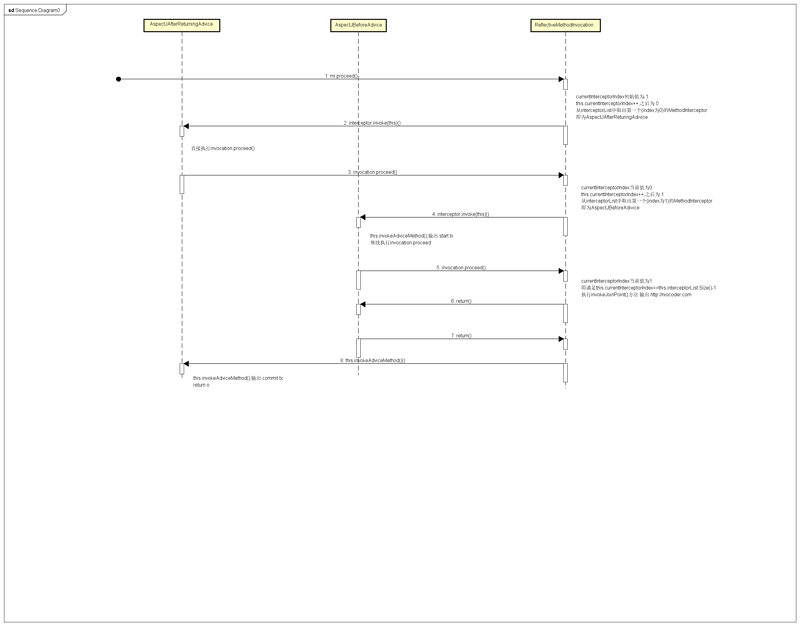spring aop之链式调用的实现
概述
AOP(Aspect Orient Programming),我们一般称为面向方面(切面)编程,作为面向对象的一种补充,用于处理系统中分布于各个模块的横切关注点,比如事务管理、日志、缓存等等。 Spring AOP采用的是动态代理,在运行期间对业务方法进行增强,所以不会生成新类,Spring AOP提供了对JDK动态代理的支持以及CGLib的支持。本章我们不关注aop代理类的实现,我简单实现一个指定次序的链式调用。
实现链式调用的
MethodInterceptor定义拦截器链,MethodInvocation 递归进入下一个拦截器链中。类图如下:

MethodInterceptor
public interface MethodInterceptor {
Object invoke(MethodInvocation invocation) throws Throwable;
}
MethodInvocation
public interface MethodInvocation {
Object proceed() throws Throwable;
}
AbstractAspectJAdvice
抽象类,实现MethodInterceptor
public abstract class AbstractAspectJAdvice implements MethodInterceptor{
private Method adviceMethod;
private Object adviceObject;
public AbstractAspectJAdvice(Method adviceMethod, Object adviceObject) {
this.adviceMethod = adviceMethod;
this.adviceObject = adviceObject;
}
public Method getAdviceMethod() {
return this.adviceMethod;
}
public void invokeAdviceMethod() throws Throwable {
adviceMethod.invoke(adviceObject);
}
}
AspectJBeforeAdvice
前置通知
public class AspectJBeforeAdvice extends AbstractAspectJAdvice {
public AspectJBeforeAdvice(Method method, Object adviceObject) {
super(method, adviceObject);
}
@Override
public Object invoke(MethodInvocation invocation) throws Throwable{
this.invokeAdviceMethod();
Object o = invocation.proceed();
return o;
}
}
AspectJAfterReturningAdvice
后置通知
public class AspectJAfterReturningAdvice extends AbstractAspectJAdvice {
public AspectJAfterReturningAdvice(Method method, Object adviceObject) {
super(method, adviceObject);
}
@Override
public Object invoke(MethodInvocation invocation) throws Throwable{
Object o = invocation.proceed();
this.invokeAdviceMethod();
return o;
}
}
ReflectiveMethodInvocation
实现MethodInvocation,proceed()方法递归实现链式调用。
public class ReflectiveMethodInvocation implements MethodInvocation {
private final Object targetObject;
private final Method targetMethod;
private final List<MethodInterceptor> interceptorList;
private int currentInterceptorIndex = -1;
public ReflectiveMethodInvocation(Object targetObject, Method targetMethod, List<MethodInterceptor> interceptorList) {
this.targetObject = targetObject;
this.targetMethod = targetMethod;
this.interceptorList = interceptorList;
}
@Override
public Object proceed() throws Throwable {
if (this.currentInterceptorIndex == this.interceptorList.size() - 1) {
return invokeJoinPoint();
}
this.currentInterceptorIndex++;
MethodInterceptor interceptor =
this.interceptorList.get(this.currentInterceptorIndex);
return interceptor.invoke(this);
}
private Object invokeJoinPoint() throws Throwable {
return this.targetMethod.invoke(this.targetObject);
}
}
NioCoderService
模拟service类
public class NioCoderService {
public void testAop() {
System.out.println("http://niocoder.com/");
}
}
TransactionManager
模拟通知类
public class TransactionManager {
public void start() {
System.out.println("start tx");
}
public void commit() {
System.out.println("commit tx");
}
public void rollback() {
System.out.println("rollback tx");
}
}
ReflectiveMethodInvocationTest
beforeAdvice->afterReturningAdvice
测试类,测试通知
public class ReflectiveMethodInvocationTest {
private AspectJBeforeAdvice beforeAdvice = null;
private AspectJAfterReturningAdvice afterReturningAdvice = null;
private NioCoderService nioCoderService;
private TransactionManager tx;
public void setUp() throws Exception {
nioCoderService = new NioCoderService();
tx = new TransactionManager();
beforeAdvice = new AspectJBeforeAdvice(TransactionManager.class.getMethod("start"), tx);
afterReturningAdvice = new AspectJAfterReturningAdvice(TransactionManager.class.getMethod("commit"), tx);
}
public void testMethodInvocation() throws Throwable {
Method method = NioCoderService.class.getMethod("testAop");
List<MethodInterceptor> interceptorList = new ArrayList<>();
interceptorList.add(beforeAdvice);
interceptorList.add(afterReturningAdvice);
ReflectiveMethodInvocation mi = new ReflectiveMethodInvocation(nioCoderService, method, interceptorList);
mi.proceed();
}
public static void main(String[] args) throws Throwable {
ReflectiveMethodInvocationTest reflectiveMethodInvocationTest = new ReflectiveMethodInvocationTest();
reflectiveMethodInvocationTest.setUp();
reflectiveMethodInvocationTest.testMethodInvocation();
}
}
输出:
start tx
http://niocoder.com/
commit tx
时序图 beforeAdvice->afterReturningAdvice


afterReturningAdvice->beforeAdvice
修改interceptorList的顺序
public void testMethodInvocation() throws Throwable {
Method method = NioCoderService.class.getMethod("testAop");
List<MethodInterceptor> interceptorList = new ArrayList<>();
interceptorList.add(afterReturningAdvice);
interceptorList.add(beforeAdvice);
ReflectiveMethodInvocation mi = new ReflectiveMethodInvocation(nioCoderService, method, interceptorList);
mi.proceed();
}
输出:
start tx
http://niocoder.com/
commit tx
时序图 afterReturningAdvice->beforeAdvice


代码下载
github:https://github.com/longfeizheng/data-structure-java/blob/master/src/main/java/cn/merryyou/aop
代码下载
github:https://github.com/longfeizheng/data-structure-java
以上就是本文的全部内容,希望对大家的学习有所帮助,也希望大家多多支持我们。

